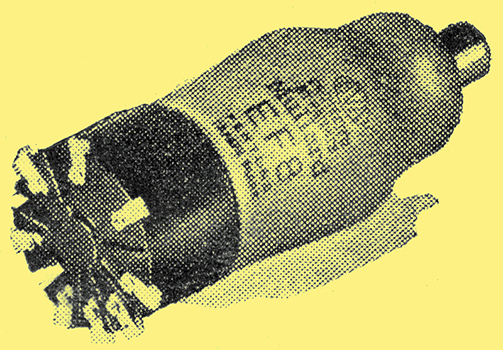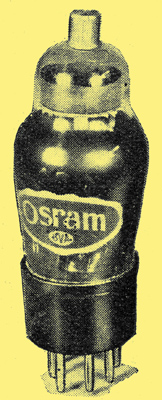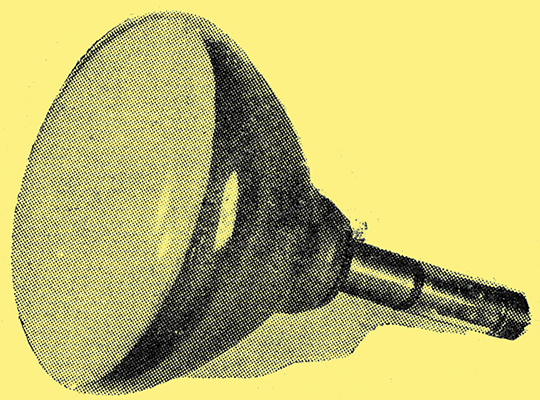|

Mullard low-noise RF pentode, EF8.
The year's development in valves has, as usual, resulted in an increase in the number of types and also rather un-expectedly an increase in the valve bases. Mullard have introduced the E series of valves. These have 6.3 Volt 0.2 Amp. heaters in most cases and side-contact bases of the Continental type. The range is a complete one, including all the normal types, such as RF pentodes, triodes, diodes, output pentodes, rectifiers, heptodes, and so on. It does, however; include one valve of a type not to be found in other ranges. This is the EF8. Officially described as a low-noise RF pentode, the valve is actually a hexode, since it includes an extra grid between the control and screen grids. The purpose of this grid is to introduce a beam formation into the electron stream so that the electrons can pass between the wires of the screen grid without striking them. The result is a great reduction in screen current and improvement in the signal-noise ratio.
This firm has also introduced some midget valves for use in deaf aids. The DAS1 is a tetrode with top anode connection and a mutual conductance of 0.58 mA/V, while the DAS3 is a triode of AC resistance 7,600 Ω and mutual conductance 0.62 mA/V. The valves have a special 4-pin base, a diameter of 16 mm., and an overall length of 69 mm.
Osram also have introduced midget valves, the S12, H12 & L12. Of these the first is a tetrode and the others are triodes. Their filaments are rated at 2 Volts 0.05 Amp. A new battery duo-diode-triode is to be found in the range of ordinary battery valves, this is the HD23, and there is also the X23 battery triode-hexode for superheterodyne frequency-changing.
The range of 6.3 Volt valves has been extended by the addition of a low-resistance triode, the L63, and there is a new AC/DC output tetrode entitled KT33. Of especial interest to designers of PA equipment is the DA250. This is a triode for 250 Watts anode dissipation, and a pair in Class AB1 push-pull will give an output of 400 Watts. In Class AB2 push-pull - that is, with some positive drive - a pair will deliver no less than 800 Watts output. Another new valve of rather especial interest is the KT8. This is similar to the KT66, but has a 7-pin base and a top-anode connection; moreover, it is rated for 600 Volts anode potential with 300 Volts on the screen grid. The mutual conductance is 4.5 mA/ V. Used as a transmitting RF amplifier, an output of 25 Watts can be obtained at 60 MHz and 43 Watts at 20 MHz. Because of its top-anode connection, the valve should also prove useful for the output of the line time-base in television equipment. It is priced at 22s. 6d. Another transmitting valve is the DET14, which is rated for 55 Watts dissipation. It is a triode and is suitable for operation up to 120 MHz.
Mazda now have ranges of 4 Volt mains valves and 2 Volt battery valves with an octal base. This is not the same octal base as that adopted by other firms. Among the more interesting types are the SP41 and SP42. The SP41 has a mutual conductance of 8.5 mA/V with grid-earth and anode-earth capacities of 11 pF and 4.75 pF respectively. At 45 MHz the input resistance is 2,200 Ω. The SP42 is a similar valve, but rated for 100 volts on the screen and intended for use in a VF stage. This firm also has an indirectly heated voltage-doubler rectifier. This is the UD4I, and it consists of two rectifiers in one envelope with the anode of one internally connected to the cathode of the other. With 500 Volts RMS input an output of 1,240 Volts DC at 20 mA can be obtained.

Osram KTZ41 television RF pentode with mutual conductance of 12 mA/V.
The Osram television valve is the KTZ41 a tetrode rated for 250 Volts anode and screen potentials. With a bias of -1.5 Volt the mutual conductance is no less than 12 mA/V new diode, the E922, has also been produced for the detector of television receivers. Mullard have a valve of the secondary-emission multiplier type with a mutual conductance of, about 20 mA /V. This is the EE50 and is of special construction, the usual base being. absent.
In addition to their well-known ranges with the standard British bases and with the American Octal-base, Tungsram now have a series of valves with the Continental side-contact. base. The range is the E series and the EF6 is recommended for short-wave work by virtue of its low capacity and high impedance. The input capacity is given as 5.4 pFand the output as 6.9 pFwhile at 60 MHz the input resistance is as high as 9,000 Ω. The mutual conductance is 2 mA/V.
Of particular interest to transmitters is a valve which can operate up to 270 MHz. It is the OQQ50/1500 - a triode with grid and anode brought out directly through the glass to reduce capacities to a minimum. It is rated at 50 Watts with 1,500 Volts anode potential.
Cossor have extended their range of 0.2 Amp AC /DC valves by the 202SPB and 202VPB RF pentodes. The former is the straight valve and the latter the variable-μ. Both these valves have top-grid connectors, but the 202VPB has a counterpart with a top anode the 202VP. A directly heated output triode with a filament taking 2 A at 2 Volts is now available. This is the 2XP, and it takes an anode current of 50 mA with 300 Volts HT supply.
Hivac have introduced a high-voltage half-wave rectifier for use with cathode-ray apparatus. It is the HVU1 and is priced at 15s 6d; it is rated for 3 mA at 6,000 Volts. Gas-triodes for saw-tooth oscillators are now produced by this firm. There is the GR1 for television purposes - it is argon filled and priced at 20s., and the GR2 mercury-filled valve for oscilloscope use.
Cathode-ray tubes are now a product of this firm, and two types are listed. The CR3 has at 3 in screen and a 7 pin base. The screen is green, and two of the deflector plates are internally connected to the third anode. It is priced at 42s. A similar tube the CR3A has a blue screen, and all deflector plates are brought out to the 9-pin base; it costs 47s. 6d. Cathode-ray tubes of various types are shown by Vacuum Science Products, and of especial interest is a 10 in tube which is priced at 7 guineas. It is obtainable for either electrostatic or magnetic focusing.

Ediswan 9 inch television CR tube of the short type for magnetic focusing and deflection.
In general the new cathode-ray tubes for television are magnetic types, and they are usually much shorter than their predecessors. The Mazda tubes have only grid, cathode with its heater, and anode for an electrode assembly, focusing and deflection being accomplished by means of externally mounted coils. Mullard tubes, however, have two anodes, the first of which operates at about 100-250 Volts, while the second is rated for 4,000-8,000 Volts, according to the type of tube. These tubes are available with screen diameters of about 9 in, 12 in, and 15 in.
The advantage of the new short tube is that it can be mounted horizontally for direct viewing in a cabinet of only moderate depth. Its disadvantage is that as the deflection angle is greater, the output of the time-bases must be greater.
Because of this, Cossor have adhered to the normal tube length in their new magnetic types, and the tubes of Vacuum Science Products, referred to above, are actually longer than many of the so-called normal types, the increase in length being made to reduce the scanning power needed.

Osram 4051 CR tube for oscilloscope use.
Apart from television tubes, Cossor, Ediswan, and Mullard have a wide range of small types for oscilloscopes. GEC have also a 1½ in screen tube, the 4051, and a 2½ in model, the 4052. These are for quite low-voltage operation, the 4051 functioning successfully off only 350 Volts.
|